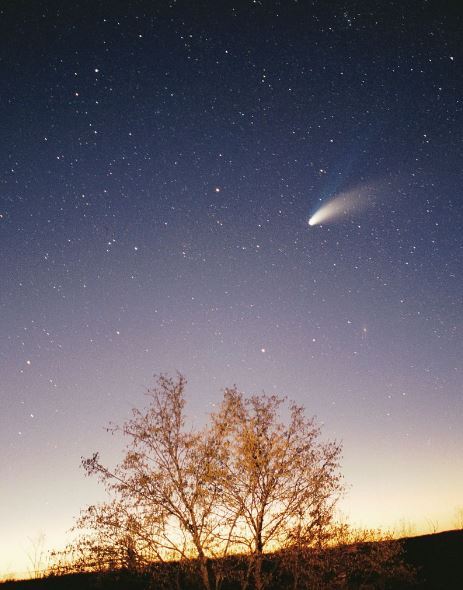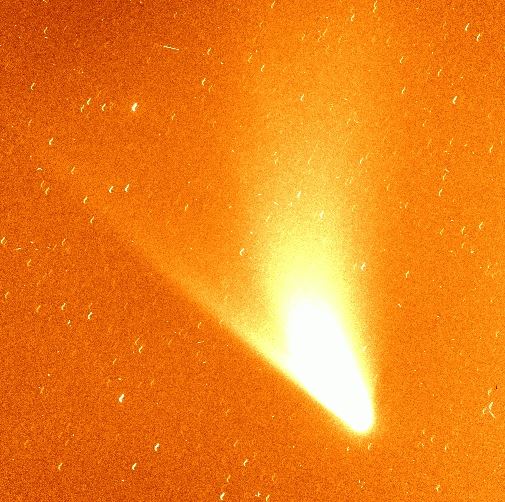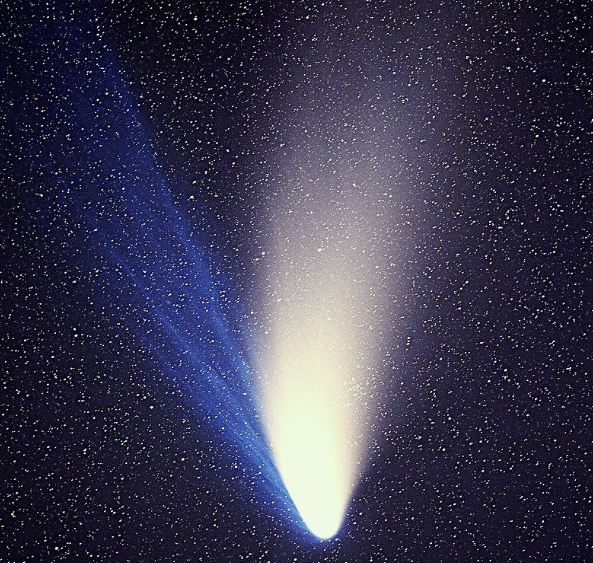Comets are one of the most studied celestial objects by astronomers. Over the years, there has been increased study and research on many of them as they appear close to Earth and provide indications about space. These comets are sometimes traveling for hundreds of years in their orbit. One such comet is the Comet Hale-Bopp which has an orbital distance of 2533 years and was last seen in the year 1997. This comet is among one of the most studied comets in our solar system for several reasons.
Overview of Comet Hale-Bopp
The Comet Hale-Bopp is a comet that appeared in 1995 independently by two observers from the US named Alan Hale and Thomas Bopp. Comet Hale-Bopp is officially named C/1995 O1 and was one of the most studied comets in the 20th century. This is because of the advanced technology, spacecraft, and telescopic vision on Earth. It is also because this was the last major comet sighting in the 20th century.
One of the most interesting aspects about this comet is that it was visible to the naked eye for over 18 months, mainly because the nucleus of this comet was bigger than many other comets. For this reason, it is also sometimes referred to as The Great Comet of 1997. It broke the record of many previous comet appearances such as The Great Comet of 1811 which had the previous record for big nucleus size as well as high magnitude. The nucleus of this comet was between 20 and 45 miles across. On 1st April 1997, the comet reached the perihelion. The perihelion distance of this comet was 0.914 Astronomical Units.
Discovery of Comet Hale-Bopp
Alan Hale and Thomas Bopp individually discovered a comet on 23rd July 1995 which was named the Hale-Bopp Comet. However, the story of the discovery of this comet is quite an interesting one. Alan Hale was spotting new comets from his driveway in New Mexico. He didn’t have much success in spotting any new comet. However, on the night of 23rd July 1995, Alan Hale discovered this comet which had an apparent magnitude of 10.5 and was near the globular cluster M70.
To confirm whether this was a new comet or a previously discovered one, he took assistance from the directory of known comets and found out that there were no comets in this part of the sky. Upon confirmation, he emailed the Central Bureau for Astronomical Telegrams regarding this discovery. This bureau was responsible for all the astronomical discoveries, records, and other associated procedures. Alan Hale kept on emailing the Bureau for new and updated coordinates.
The story of how Thomas Bopp discovered the comet is quite a funny one. Although he didn’t have a telescope of his own, he still loved star gazing. On 23rd July 1995, Bopp was out with his friends in the State of Arizona near Stanfield. He was observing stars and galaxies with his friend’s telescope. Suddenly, he felt that he was observing something new and different.
Like Alan Hale, he also checked maps to determine if it was something already discovered or something new. Upon confirmation, he sent a telegram to Central Bureau for Astronomical Telegrams which was considered funny as emails were quite popular at that time and Alan Hale had already sent 3 emails with updated coordinates during the time the telegram was being sent and received.
By the time of discovery, the comet was the farthest one ever to be spotted by astronomers, as reported by NASA. The discovery of this comet was announced in the International Astronomical Union Circular 6187. It was one of the most important comet discoveries in a long time.
Timeline of Comet Hale-Bopp
The first discovery of this comet was in 1995. In the next year, May 1996, the comet became visible from the naked eye as well and the rate of brightening slowed down as well. The comet came too closely aligned to the sun which is why it became less visible compared to the sun in December 1996. The comet reappeared in January 1997 when it was a bit away from the sun’s alignment. It was bright enough to be seen from almost all parts of the world.
The comet got brighter by this point and shone at a 2nd magnitude in the month of February. Other visible aspects of the comet at that time include a blue gas tail pointing away from the sun as well as a yellow dust tail curving along the orbital pattern.
By March 9, there was a solar eclipse in China and neighboring countries which allowed the observers to view this comet in the daytime as well. On March 22, 1997, the comet was at its closest to the Earth with a distance of 1.315 astronomical units.
NASA observed that the comet was at its closest on 22nd March 1997 at a distance of 120 million miles.
On 1st April, the comet reached the perihelion and was brighter than any visible star except star “Sirius”. The comet used to get really bright during the night sky and was visible clearly to the observers in the Northern Hemisphere.
Soon afterward, as the comet exited the perihelion, it moved into the Southern Celestial Hemisphere but it wasn’t as bright as it was earlier. It was visible for quite a long time since then. By December 1997, there were last visible eye observations of the comet. Accordingly, the comet was visible for a total of 569 days to the naked eye.
The comet then began the return journey but astronomers were still able to keep a track of this comet because of constantly improving astronomical equipment and technology. In October 2007, the comet was discovered at a distance of 25.7 astronomical units while in 2010, the Herschel Space Observatory noticed it once again in a layer of fresh frost. The last known observation of the Hale-Bopp comet was on 7th August 2012 when it was 33.2 astronomical units from the sun.
Observations of Comet Hale-Bopp
When Comet Hale-Bopp was initially discovered in 1995, it was at 7.2 astronomical units from the sun which was the farthest distance of a comet to be discovered on Earth. Astronomers began to study the comet at this time and found that the Anglo-Australian Telescope had taken a photograph in 1993 but no one noticed the comet. At this time, it was 13 astronomical units from the sun and the comet was barely observable at that time. Initial studies also showed that the comet was 6 to 8 times bigger than Comet Halley.
Astronomers also realized that as the comet reached the perihelion, it would be even brighter because it will be way close at this point. However, comets can vary in chemical compositions and properties which is why it was highly unpredictable to evidently conclude that.
Orbital observations of the comet concluded that the orbital period of this comet was around 4200 years. This would have been 4385 years but there were slight changes in the orbit of this comet which is why the distance was reduced. This could have occurred because Comet Hale-Bopp had a close call with Jupiter in June 2215 and was about to collide with it. By 1996, the comet once again went close to Jupiter at a distance of 0.77 astronomical units which is why the comet’s orbit is now reduced to about 2,533 years.
Researchers found out that the comet made the closest approach to Earth at a distance of 1.4 astronomical units. Due to an orbit that has an intersection with Earth’s Orbit, there is a highly rare chance that it could collide with the Earth.
Upon chemical observations of the comet, it was found out that this comet had a sodium tail. This was a unique type of tail not previously known and emitted sodium which extended to about 50 million km in length. Astronomers suggested that the Hale-Bopp comet had sodium coming from its inner coma.
Studies also found out that this comet had high volumes of deuterium which was twice the amount of Earth’s oceans. There were also traces of Deuterium in other hydrogen compounds and the ratio was varying from compound to compound. This also implied that the comet may have the presence of water.
Scientists also realized that there are many organic chemicals on this comet, some of which were quite new and had never been discovered on a comet before. They were detected within the cometary nucleus and could be a result of chemical reactions.
One surprising discovery regarding Comet Hale-Bopp was that there were signs of argon gas in this comet. There was also Krypton and a few other noble gasses in it. These observations suggested that the comet was much colder than anticipated. It also suggested that the comet was formed beyond the planet Neptune where there was an ample source of argon gas.
It was also quite odd that the comet was not having a uniform orbit rather the outgassing was spread in an uneven manner. Observations allowed astronomers to that the rotation period of the comet was around 11 hours and 46 minutes.
As technology and media were already playing an important role in astronomy, comets like these were observed on a major scale. This comet was one of the most observed comets. At one point, the website of NASA was handling 1.2 million requests due to which there was a jam of internet traffic at the website that also resulted in the crashing of the website.
Conclusion
Comet Hale-Bopp was one of the most observed comets in our solar system and stands as an important comet for the numerous chemical properties, orbital changes, abnormal uniformity, and various other aspects as well. After Comet Halley, it is a highly studied comet that has led astronomers into discovering more about the solar system.




